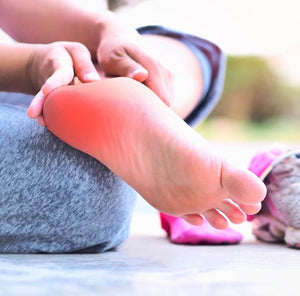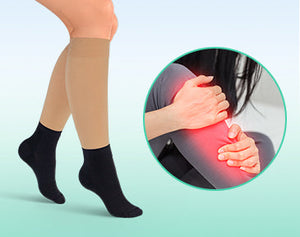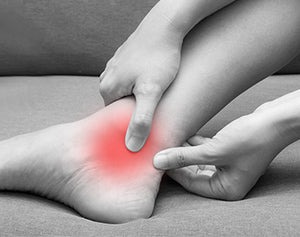The Orthofeet Blog
- All Posts
- Achilles Tendon Pain
- All
- Arch Support
- Arthritis
- Back Pain
- Bunions
- Diabetes
- Flat Feet
- Foot Pain
- Golf Shoes
- Hammer Toes
- Heel Pain
- Heel Pain/ Heel Spurs
- Knee & Hip Pain
- Knee pain
- Morton Neuroma
- Neuropathy
- Orthopedic shoes
- Other
- Overpronation
- Plantar Fasciitis
- Swollen Feet
Plantar Fasciitis


Josh White DPM / August 12, 2021
Hiking with Plantar Fasciitis: What You Need to Know
Hiking with Plantar Fasciitis: What You Need to Know
Read Post-
Why Do My Heels Hurt? Causes, Walking Pain, and Relief Tips
Medical information provided by Orthofeet Team / August 27, 2025Pain in the feet, especially in the heels, can be debilitating and requires proper attention. If you often wonder why your feet hurt every day, you're not alone. Heel pain is one of the most common foot problems, affecting millions of people and can significantly impact daily activities, from your morning routine to evening walks, for some, it’s heel pain from shoes. Understanding why the heel of your foot hurts is crucial to finding effective treatment and resuming pain-free movement. A podiatrist can help diagnose the root cause of the heel pain. Common Causes of Heel Pain Heel pain can arise from various causes, often linked to excessive activity, foot structure, or stress fractures. The heel bears significant weight with every step, making it vulnerable to various injuries and inflammatory conditions. Exercise and stretching, along with wearing shoes for heel pain, play a crucial role in managing pain and improving foot health. If you spend long hours on your feet, incorporating the 9 ways to stop foot pain from standing all day into your routine can also help reduce strain and prevent further injury. In rare cases, persistent heel pain may prompt questions like "Is heel pain a sign of cancer?" though most causes are far less serious. Plantar Fasciitis Plantar fasciitis is the most common cause of heel pain, affecting approximately 10% of people at some point in their lives [1]. This condition occurs when the plantar fascia, a thick band of tissue that runs along the bottom of your foot from heel to toes, becomes inflamed or develops small tears. The plantar fascia acts like a bowstring, supporting the arch of your foot and absorbing shock during walking. When this tissue becomes overstretched or strained, it can cause sharp, stabbing pain typically felt on the bottom of the heel. Plantar fasciitis shoes with strong arch support and cushioning can significantly help relieve discomfort. Explore Orthofeet’s plantar fasciitis-friendly shoes for added support and pain relief. Classic symptoms include severe pain with the first steps in the morning or after sitting for extended periods. The pain often improves with movement but may return after long periods of standing or walking. Poor footwear, sudden increases in activity, or foot structure abnormalities can all contribute to plantar fasciitis development, sometimes producing a burning sensation in the heel. Achilles Tendinitis Achilles tendinitis causes pain at the back of the heel and is often related to overuse or tight calf muscles. The Achilles tendon connects your calf muscles to your heel bone, and when this tendon becomes inflamed, it can create significant discomfort. This condition is particularly common in runners, people who climb stairs frequently, or those who suddenly increase their physical activity level. The pain typically develops gradually and may be accompanied by stiffness, especially in the morning or after periods of rest. Unlike plantar fasciitis, which affects the bottom of the heel, Achilles tendinitis pain is felt at the back of the heel and may extend up the lower leg. Shoes designed for Achilles tendinitis can help reduce strain on the tendon and alleviate pain. Discover Orthofeet's shoes for Achilles tendinitis for better support and comfort. Heel Spurs Heel spurs are bony growths that develop on the underside of the heel bone, often in response to chronic plantar fasciitis. While the spurs themselves aren't always painful, they can cause discomfort when they irritate surrounding soft tissues. Many people with heel spurs experience a dull ache when standing or walking, which may progress to sharp, stabbing pain. The pain often feels like stepping on a nail or sharp stone, particularly with the first steps after rest. Heel spurs develop over time as the body attempts to repair and strengthen the plantar fascia attachment. They're more common in people over 40 and those with certain foot structure abnormalities. Shoes that provide maximum cushioning and shock absorption can help relieve heel spur pain. Shop Orthofeet’s heel spur shoes for extra support and pain relief. Bursitis and Nerve Irritation Heel bursitis occurs when the small, fluid-filled sacs (bursae) that cushion the heel area become inflamed. These sacs normally provide lubrication between bones, tendons, and muscles, but repetitive motion or pressure can cause them to swell and become painful. The pain from heel bursitis typically feels deep and achy, often triggered by activities that put pressure on the heel or involve repetitive motion. Nerve irritation, such as tarsal tunnel syndrome, can cause burning, tingling, or numbness in the heel area. This condition occurs when the tibial nerve becomes compressed as it passes through the tarsal tunnel near the ankle, creating symptoms similar to carpal tunnel syndrome in the wrist. Why Heel Pain Is Worse When Walking Understanding why my heel hurts when I walk involves recognizing how movement affects inflamed or injured tissues. Walking increases pressure and stress on the heel structures, particularly when proper support is lacking. Improper Footwear and Lack of Support Unsupportive shoes are often the primary reason why my heel hurts when I walk after sitting. Shoes with flat soles, worn-out cushioning, or inadequate arch support force the heel to absorb excessive impact with each step. High heels shift weight forward, placing unusual stress on the heel and forefoot. Conversely, completely flat shoes like flip-flops provide no arch support, causing the plantar fascia to overstretch and the heel to bear more weight than it should. Worn-out athletic shoes lose their shock-absorbing properties over time, even if they don't appear visibly damaged. The midsole compression that occurs with use reduces the shoe's ability to protect your heel from impact forces. Foot mechanics also play a role. Overpronation (excessive inward rolling of the foot) or underpronation (insufficient inward rolling) can create uneven weight distribution, placing additional stress on specific areas of the heel. Proven Ways to Relieve Heel Pain at Home Many people find significant relief from heel pain without surgery or prescription medications. Consistent application of conservative treatments often leads to substantial improvement over time. Stretching and Foot Exercises Daily stretching can improve flexibility and reduce strain on the plantar fascia and Achilles tendon, helping relieve tenderness and inflammation. Effective stretches include: Calf stretches: Stand arm's length from a wall, place your hands against it, and step your affected foot back, keeping the heel down Towel stretches: Sit with legs extended, loop a towel around the ball of your foot, and gently pull toward you Plantar fascia stretches: Pull your toes back toward your shin while seated Tennis ball rolls: Roll a tennis ball under your foot to massage the plantar fascia Perform these stretches 2-3 times daily, holding each stretch for 30 seconds. Consistency is more important than intensity - gentle, regular stretching is more effective than aggressive stretching performed sporadically. Rest and Ice Activity modification is crucial during acute heel pain episodes. Avoid high-impact activities like running or jumping, and limit prolonged standing when possible. Ice therapy helps reduce inflammation and numb pain. Apply ice to the affected heel for 15-20 minutes several times throughout the day, especially after activities that worsen symptoms. Use a thin towel between the ice and skin to prevent ice burns. Elevation can also help reduce swelling. When resting, prop your foot up on pillows to manage swelling, and reduce inflammation. Supportive Footwear and Orthotics Wearing supportive orthopedic shoes at all times - even at home - is crucial for heel pain recovery and can help prevent further injury. Slippers for heel pain at home and supportive shoes during daily activities can ease pressure and protect the heel. Avoid walking barefoot on hard surfaces, as this places maximum stress on inflamed tissues. Look for shoes with adequate arch support, cushioned heels, and shock-absorbing soles. The shoes should have enough room in the toe box to prevent crowding but fit snugly enough to prevent sliding. Orthotic insoles can transform regular shoes into therapeutic footwear [2]. These devices redistribute pressure, support the arch, and provide additional heel cushioning. Both custom-made and over-the-counter orthotics can be effective, depending on your specific needs. Pair them with heel pain shoes for men or heel pain shoes for women for maximum benefit. Why Orthofeet Is a Trusted Choice for Heel Pain Relief Orthofeet shoes address the root causes of heel pain through thoughtful design and advanced materials. Our footwear incorporates features specifically chosen to support healing and prevent future problems, addressing inflammation and potential stress fractures. How Orthofeet Helps Our ergonomic soles are designed to reduce heel impact while promoting natural foot movement. The mild rocker design encourages smooth heel-to-toe transition, reducing stress on the plantar fascia and heel structures. Premium orthotic insoles with anatomical arch support come built into every pair. These insoles provide the same benefits as custom orthotics, supporting proper foot alignment and reducing strain on the heel and arch. Styles like our heel pain sneakers combine this orthotic support with lightweight materials for all-day wear. Cushioned heels absorb shock with every step, protecting sensitive heel areas from impact forces. This feature is particularly beneficial for people with plantar fasciitis or heel spurs who experience pain with weight-bearing activities. Our seam-free interiors prevent irritation and pressure points, making them ideal for people with sensitive feet or conditions like neuropathy. The smooth construction eliminates rubbing that could worsen heel pain or create additional problems. For those needing accommodative fit, we offer options including wide widths, adjustable straps, and extra depth. These features ensure proper fit without creating pressure points that could contribute to heel pain. The combination of these features creates an environment where healing can occur while providing the support needed to prevent future problems. Daily wear of appropriate footwear can make a noticeable difference in pain levels and overall foot health.[product-group-tile]======================================= Sources: [1] American Academy of Orthopaedic Surgeons. "Plantar Fasciitis and Bone Spurs." https://orthoinfo.aaos.org/en/diseases--conditions/plantar-fasciitis-and-bone-spurs/ [2] Journal of Foot and Ankle Research. "The effectiveness of foot orthoses in the treatment of plantar fasciitis." https://jfootankleres.biomedcentral.com/articles/10.1186/s13047-017-0229-2Read More







